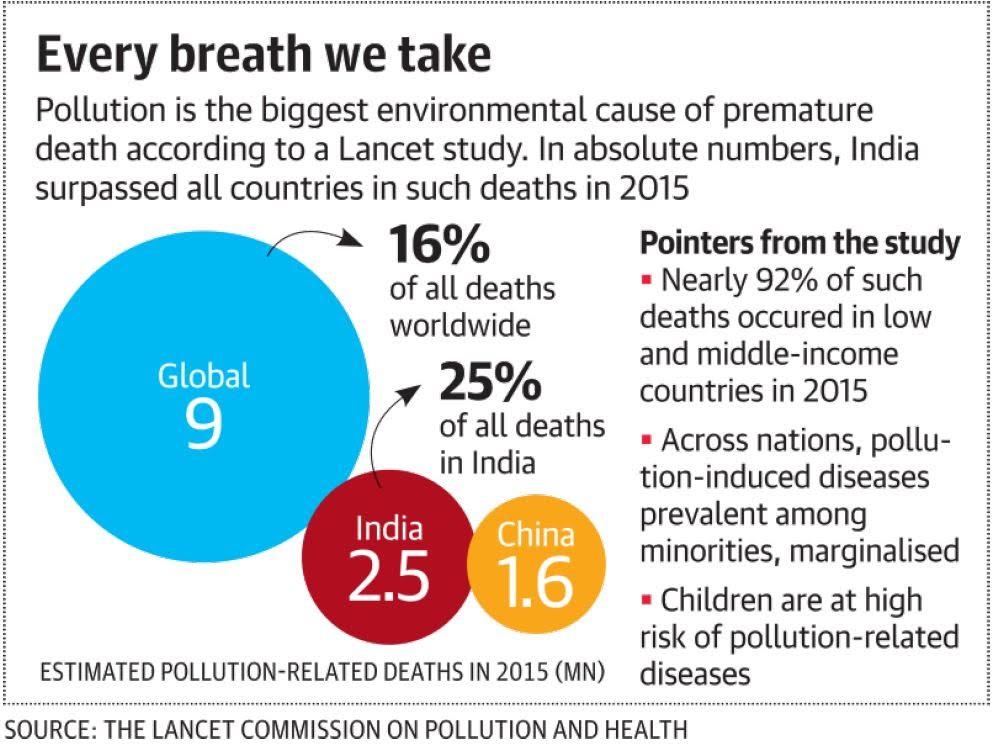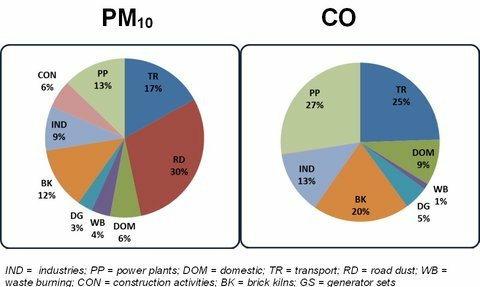(HOT) UPSC Current Affairs 2025 PDF
NEW! The Gist (NOV-2025) | E-BOOKS
Air pollution crisis in India : Important Topics for UPSC Exams
Air pollution crisis in India : Important Topics for UPSC Exams
With every winter comes the news of elevated pollution levels in the national capital. The problem of pollution disrupts not only the NCR area but many other prominent urbane areas like Allahabad and Ludhiana which figure above Delhi in the pollution ranking across the world. This articles deals with the various aspects of the problem and propose solutions for it resolution.
Reasons of air pollution in India:
-
High dependence on coal for power: share of coal in power generation in India continue to be around 80%. Power plants with poor technology and efficiency continue to be the major source of pollutants like CO and oxides of nitrogen and sulfur
-
High levels of poverty
-
Dependence on fuelwood and kerosene for the purpose of lighting and cooking leads to high level of pollutants being released in rural and urban periphery
-
Over exploitation of commons like forests, grazing lands and mindless deforestation reduces the natural capacity to absorb pollutants
-
-
Poor governance: the issue of environment and pollution is still to get the policy priority it deserves. While agencies liked CPCB and SPCBs continue to be under-resourced and under-staffed, multiplicity of the state authorities at the ground level leads to poor coordination, lax enforcement of rules and lack of accountability as seen in Delhi. Absence of environmental governance continues to be a major challenge
-
Access to technology: India's industrial landscape continues to be dominated by MSMEs which lack access to cleaner technologies. Agricultural waste burning is also the result of poor access to farm technologies
-
Unplanned urbanization: haphazard growth of urban areas has led to proliferation of slums and poor public transport has increased the burden of personal vehicles on the road. Landfills used for waste management also releases pollutants in the air. The rapid urbanization of the recent years if left unmanaged will further exacerbate the problem
-
Continentality: problem of pollution in the landlocked northern states gets exacerbated due to unfavorable winds and phenomenon of temperature inversion during winters
Impacts of air pollution:
-
Health: increased burden of non-communicable diseases such as cancer, cardiac diseases, COPD etc. is the direct consequence of rise in air pollution. According to Lancet estimates on 2015 there were 2.51 million pollution related deaths in India. It reduces the overall productivity of nation and increases the healthcare burden especially on the poor

Image Source: The Hindu
-
Environment: pollution affects not only health of humans but of environment too. Birds and plants are affected by air pollution and phenomenon like urban heat island resulting from it
-
Economy: increased healthcare costs, reduced productivity, diversion of resources towards responding to air pollution are some of the economic costs. According to WB estimate, air pollution might have cost India 8.5% of GDP
-
Politics: air pollution has caused major political conflict in last few years, most prominent of which is the recurring conflict among Punjab, Haryana and Delhi
Sources of air pollution:


Initiatives by governments to curb pollution
-
Early implementation of BS-VI norm in 2020 to reduce emission from vehicles (as much as 75pc in case of NOx in diesel engine)
-
Green India mission: part of NAPCC it aims at protecting, restoring and enhancing India’s diminishing forest cover which is crucial to reduce pollution
-
Electric vehicle: the govt is pushing for EVs as a cleaner alternative to vehicles run on fossil fuels with schemes like FAME to incentivizing purchase of EVs
-
GRAP Delhi: Graded response action plan as mandated by SC for Delhi NCR to combat pollution aims to institutionalize coordination among all the concerned authorities to respond according to the severity of pollution
-
Ban on Diesel vehicle and crackers: Courts in the recent time have cracked down upon Diesel vehicles and crackers to reduce pollutant emissions
-
UJJWALA Yojana: the scheme providing subsidized LPG connections to BPL families will curb emissions from fuelwood used for cooking
-
Odd even policy: the initiative by reducing the load of personal vehicle on road has helped in slight reduction in PM levels in Delhi
-
Renewable energy plans: the aim of government to increase RE capacity by 175GW by 2022 and share of RE in total power generation to 40% by 2030 will be crucial in reducing pollution from power generation
-
Smart city, AMRUT: the urban development scheme which seek to ensure planned urban growth including public transport and waste management will address emission from urban areas
-
National Air Quality index that measures and monitors the levels of eight pollutants (PM10, PM2.5, NO2, SO2, CO, O3, NH3, and Pb)
Solution for the problem of pollution:
-
Green cover: increasing green cover especially in the urban areas must be an indispensable part of urban planning. Other initiatives such as afforestation, greening of highways etc. must also pick up
-
Push to renewables: addressing the problem of intermittence by adopting smart grid technology, incentives for decentralised power production via biogas, rooftop solar and push to EVs as has been done in Norway (exemptions on tax, toll, parking fee, environment tax on other vehicles, charging stations powered by renewable)
-
Urban governance: better urban planning based on models like transit oriented development (TOD), integrated and accountable transport authority, empowered local bodies, scientific waste management etc. can help bring down pollution footprints of urban areas
-
Market for agricultural waste: the problem of crop burning can be resolved only through financial and technological support and incentives for farmers. Access to technologies like super seeder machines and development of market for crop stubble will push farmers to a cleaner method of waste disposal
-
Better planning and coordination: a single body on the lines of EPCA as mandated by SC with clear targets and accountability mechanisms is necessary for effective environmental governance
-
Forecasting systems for better response: China has shown the way in controlling the pollution by an effective pollution forecasting (2-3 days in advance) and monitoring systems. Its permanent odd-even policy during severe pollution levels, early warning systems, strict enforcement of GRAP like action plan has significantly brought down the pollution levels in Beijing
-
Healthcare for pollution related diseases: pollution and its health burden are inevitable in the near future. Therefore it is necessary to equip public healthcare systems with adequate resources for facing this emerging challenge and shield poor from catastrophic healthcare expenditures
-
Coherent environmental policies: since air pollution knows no boundaries, states and center have to harmonize their strategy to deal with it. Platforms like inter-state council apart from serving this objective can also help resolve pollution related disputes among states
Previous year mains questions:
-
Mumbai, Delhi and Kolkata are the three mega cities of the country but the air pollution is much more serious problem in Delhi as compared to the other two. Why is this so? (2015)
MCQ
In the cities of our country, which among the following atmospheric gases are normally considered in calculating the value of Air Quality Index?
1. Carbon dioxide
2. Carbon monoxide
3. Nitrogen dioxide
4. Sulfur dioxide
5. Methane
Select the correct answer using the code given below.
(a) 1, 2 and 3 only
(b) 2, 3 and 4 only
(c) 1, 4 and 5 only
(d) 1, 2, 3, 4 and 5
In the context of solving pollution problems, what is/are the advantage/advantages of bioremediation technique?
1. It is a technique for cleaning up pollution by enhancing the same biodegradation process that occurs in nature.
2. Any contaminant with heavy metals such as cadmium and lead can be readily and completely treated by bioremediation using microorganisms.
3. Genetic engineering can be used to create microorganisms specifically designed for bioremediation.
Select the correct answer using the code given below:
(a) 1 only
(b) 2 and 3 only
(c) 1 and 3 only
(d) 1, 2 and 3
Which of the following best describes/ describe the aim of ‘Green India Mission’ of the Government of India?
1. Incorporating environmental benefits and costs into the Union and State Budgets thereby implementing the `green accounting’
2. Launching the second green revolution to enhance agricultural output so as to ensure food security to one and all in the future
3. Restoring and enhancing forest cover and responding to climate change by a combination of adaptation and mitigation measures
Select the correct answer using the code given below.
(a) 1 only
(b) 2 and 3 only
(c) 3 only
(d) 1, 2 and 3


